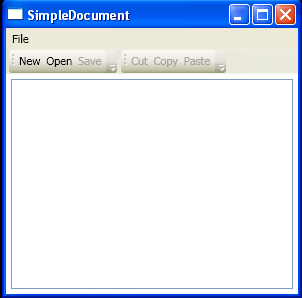Use CommandBinding to Bind to ApplicationCommands

<Window x:Class="Commands.SimpleDocument"
xmlns="http://schemas.microsoft.com/winfx/2006/xaml/presentation"
xmlns:x="http://schemas.microsoft.com/winfx/2006/xaml"
Title="SimpleDocument" Height="300" Width="300">
<Grid>
<Grid.RowDefinitions>
<RowDefinition Height="Auto"></RowDefinition>
<RowDefinition Height="Auto"></RowDefinition>
<RowDefinition></RowDefinition>
</Grid.RowDefinitions>
<Menu Grid.Row="0">
<MenuItem Header="File">
<MenuItem Command="New"></MenuItem>
<MenuItem Command="Open"></MenuItem>
<MenuItem Command="Save"></MenuItem>
<MenuItem Command="SaveAs"></MenuItem>
<Separator></Separator>
<MenuItem Command="Close"></MenuItem>
</MenuItem>
</Menu>
<ToolBarTray Grid.Row="1">
<ToolBar>
<Button Command="New">New</Button>
<Button Command="Open">Open</Button>
<Button Command="Save">Save</Button>
</ToolBar>
<ToolBar>
<Button Command="Cut">Cut</Button>
<Button Command="Copy">Copy</Button>
<Button Command="Paste">Paste</Button>
</ToolBar>
</ToolBarTray>
<TextBox Name="txt" Margin="5" Grid.Row="2"
TextWrapping="Wrap" AcceptsReturn="True"
TextChanged="txt_TextChanged"></TextBox>
</Grid>
</Window>
//File:Window.xaml.cs
using System;
using System.Collections.Generic;
using System.Text;
using System.Windows;
using System.Windows.Controls;
using System.Windows.Data;
using System.Windows.Documents;
using System.Windows.Input;
using System.Windows.Media;
using System.Windows.Media.Imaging;
using System.Windows.Shapes;
namespace Commands
{
public partial class SimpleDocument : System.Windows.Window
{
public SimpleDocument()
{
InitializeComponent();
CommandBinding binding;
binding = new CommandBinding(ApplicationCommands.New);
binding.Executed += NewCommand;
this.CommandBindings.Add(binding);
binding = new CommandBinding(ApplicationCommands.Open);
binding.Executed += OpenCommand;
this.CommandBindings.Add(binding);
binding = new CommandBinding(ApplicationCommands.Save);
binding.Executed += SaveCommand_Executed;
binding.CanExecute += SaveCommand_CanExecute;
this.CommandBindings.Add(binding);
}
private void NewCommand(object sender, ExecutedRoutedEventArgs e)
{
Console.WriteLine("New command triggered with " + e.Source.ToString());
isDirty = false;
}
private void OpenCommand(object sender, ExecutedRoutedEventArgs e)
{
isDirty = false;
}
private void SaveCommand_Executed(object sender, ExecutedRoutedEventArgs e)
{
Console.WriteLine("Save command triggered with " + e.Source.ToString());
isDirty = false;
}
private bool isDirty = false;
private void txt_TextChanged(object sender, RoutedEventArgs e)
{
isDirty = true;
}
private void SaveCommand_CanExecute(object sender, CanExecuteRoutedEventArgs e)
{
e.CanExecute = isDirty;
}
}
}
Related examples in the same category